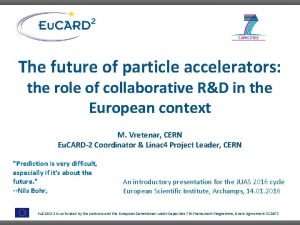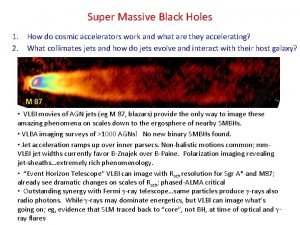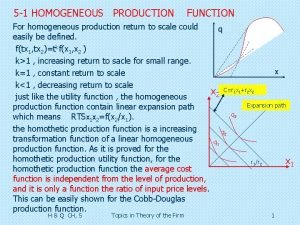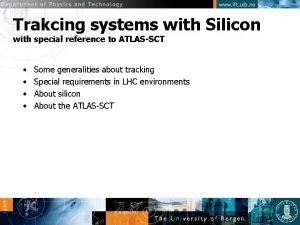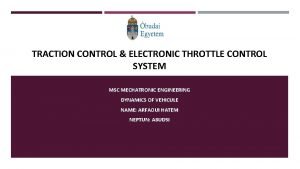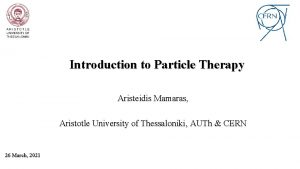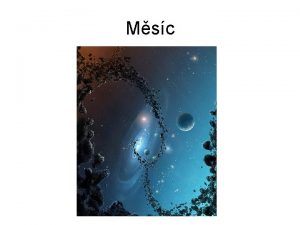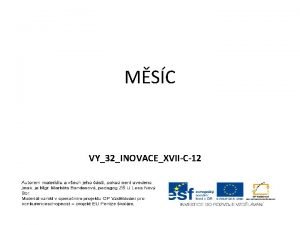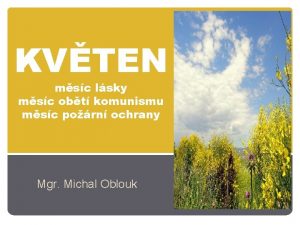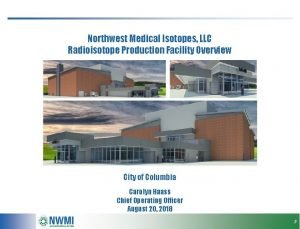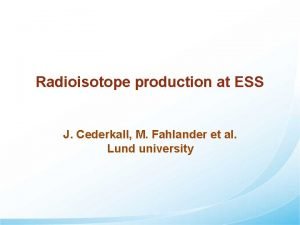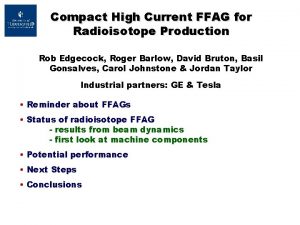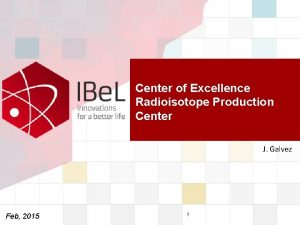Radioisotope production using linear accelerators A Mamaras MSc












- Slides: 12

Radioisotope production using linear accelerators A. Mamaras, MSc at AUTh Y. Foka, (GSI/CERN), Α. Liolios (AUTh) Thessaloniki, 6 th November, 2020

Medical radioisotope production 18 F-FDG From radioisotope 18 F to the radiopharmaceutical FDG ü Main topic of bachelor thesis work was to investigate the possibility to use linear accelerators for the production of radioisotopes commonly used for PET imaging. The Cyclone 30 isotope-producing cyclotron, 8. 3 tons ü Medical radioisotopes are usually produced by cyclotrons in dedicated facilities and transported to the hospitals for their use. ü The basic idea is to install a linac-based system for radioisotope production at or near the location where the radioisotopes are used, since linacs may offer many advantages compared to cyclotrons. Source: https: //bit. ly/3 l 5 ihdu

Possible RFQ Linac designs Source: https: //bit. ly/3 p 0 ef. FQ, M. Vretenar et al. Characteristics Accelerator length Characteristics 4 m Accelerator length 2. 5 m Surface 15 m 2 Surface 10 m 2 Weight 500 kg Weight 350 kg Output Energy 10 Me. V Output Energy Duty Cycle 10% Duty Cycle 6. 5 Me. V 4 % Power Consumption 350 k. W Power Consumption 400 k. W Operating Frequency 750 MHz

Development of numerical calculations • The production yield of 18 F commonly used for PET imaging was estimated in a certain range of energies together with the corresponding number of PET doses. • Developed a method of numerical calculations for radioisotope production to: § Search for an energy range in which we can achieve efficient radioisotope production § Keep the setup compact and cost effective § Investigate the possibility for injection to the synchrotron in the same energy range

Radionuclide Production Yield • Yield ( m. Ci or GBq) • Number of • Irradiation time • λ decay constant of target atoms per unit the radionuclide • Beam current volume • Ei is the beam energy, (μΑ) • Eth is the reaction threshold energy, q For practical reasons, saturation factor, λ, is considered • σ(E) is the excitation function, at 3. 5 T 1/2 of the radioisotope. • d. E/dx is the stopping power of the target material.

Development of numerical calculation for radioisotope production • Obtain the “range” of the particle beam inside the target from the literature. • We divide the “range” that the particles of the beam will reach, xmax, in the target in several thin slices of equal thickness Δx. • Knowing the initial kinetic energy Einput = E 1 of the particle beam impinging on the first slice, we can get from the literature the value of the stopping power S 1 =S(E 1) for this energy, which is valid in the whole slice, assuming that the stopping power is approximately constant for small variations of energy. • The energy loss of particles passing this slice must be equal to ΔE 1 = S 1·Δx 1 , and the energy of particles exiting this slice and entering into the next will be equal to E 2 = E 1 - ΔE 1 = E 1 - S 1·Δx 1. • We proceed in the same way to the following slices, the particle energy in each slice is decreasing in small but unequal steps, until it reaches zero (in the figure this happens somewhere into the 8 th slice).

Development of numerical calculation for radioisotope production

Yield calculation for 18 F production from H 218 O water target. Number of PET doses for 1 μΑ 18 F Saturation Activity for 1 μΑ 9 25. 0 8 7 Saturation activity [GBq] Number of PET doses 20. 0 15. 0 10. 0 6 5 4 3 2 5. 0 1 0. 0 0 0 2 4 6 8 Beam energy [Me. V] 10 12 14 16

Possible RFQ Linac designs Source: https: //bit. ly/3 p 0 ef. FQ, M. Vretenar et al. Saturation yield after 3. 5 T 1/2 ≅ 6 h: 104 GBq → 282 PET doses ü Saturation yield after 3. 5 T 1/2 ≅ 6 h: 74 GBq → 200 PET doses 18 F arriving from Athens, by plane and/or car → Great yield loss. ü The produced yield at the production laboratory is 120 GBq out of which only 15 GBq reach the hospital (after 5 -6 hours) and 4. 4 GBq are finaly used. ü This loss can be avoided with a production unit close to the hospital → Possible linac setup designs.

Possibility of radioisotope production in SEEIIST facility ü Possibility for an extension to construct a unit dedicated to the extraction of the produced radioisotope from the target and the production of radiopharmaceuticals. ü The surplus of radioisotope quantities could be made available to other hospitals. ü Research field for exploring more promising radioisotopes for diagnostic and therapeutic purposes.

Conclusions and Outlook • The possibility of using linacs for radioisotope production looks promising. • Study the simultaneous optimization of the parameters needed for the production of these radioisotopes, by a compact cost effective linear accelerating system that could also be used for injection to the synchrotron. • Optimize the design of this area including efficient radioprotection methods, shielding calculations and appropriate construction materials.

Thank you!
 3 proses produksi multimedia
3 proses produksi multimedia The long-term future of particle accelerators
The long-term future of particle accelerators Accelerators computer architecture
Accelerators computer architecture Slidetodoc
Slidetodoc Good to great technology accelerators
Good to great technology accelerators Good to great technology accelerators
Good to great technology accelerators Cosmic super accelerators
Cosmic super accelerators Analytics query accelerators
Analytics query accelerators Homogeneous production function
Homogeneous production function Trakcing
Trakcing Nazvn
Nazvn Stretto di gibilterra larghezza
Stretto di gibilterra larghezza What is an msc?
What is an msc?

